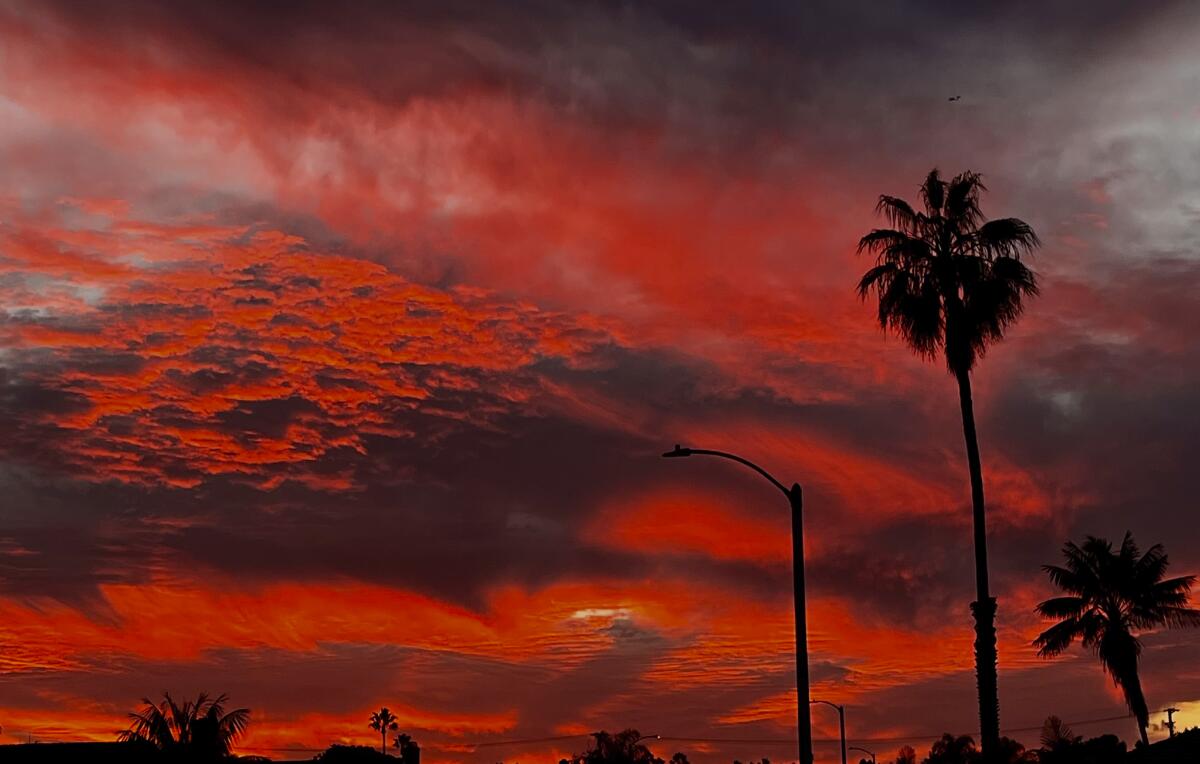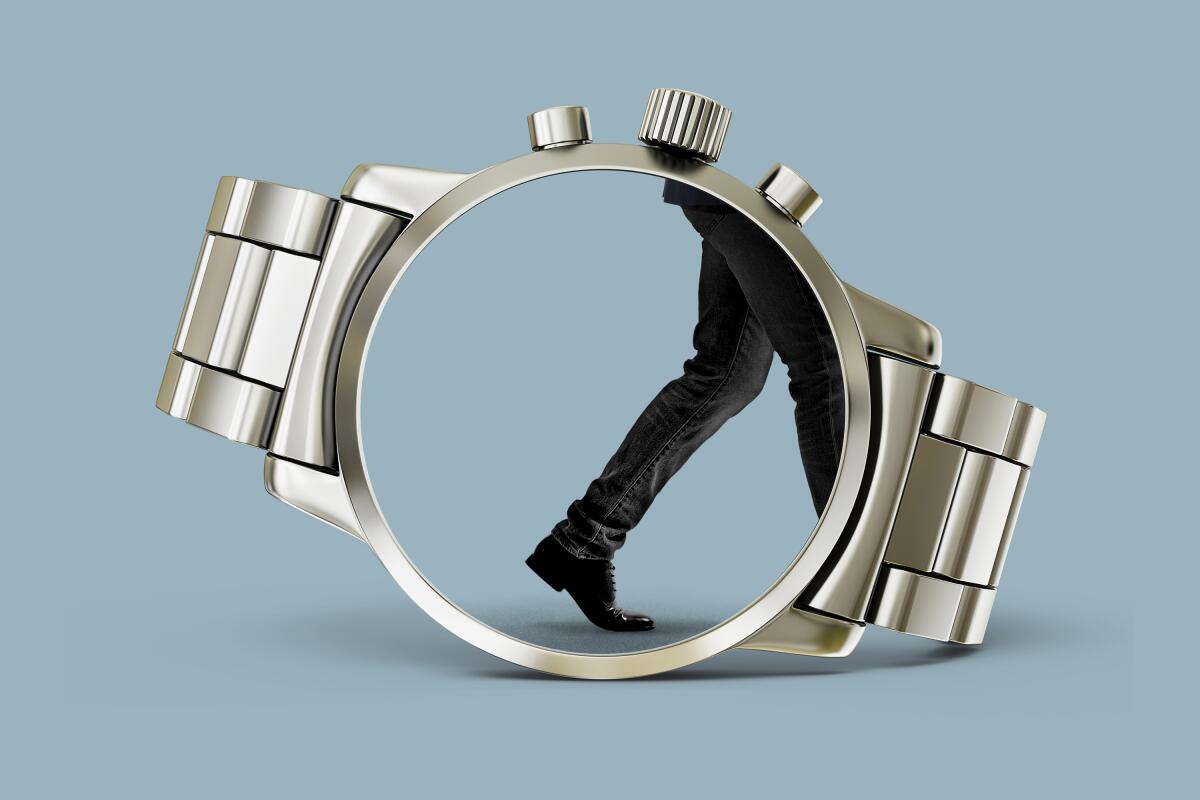Why palm trees make less sense in a warming world

- Share via
Good morning. It’s Monday, Oct. 2. Here’s what you need to know to start your day.
- Palm trees don’t work in a warming world
- Newsom tapped Laphonza Butler for Feinstein’s Senate seat
- U2 met its match at the Las Vegas Sphere
- And here’s today’s e-newspaper
Sign up for Essential California
The most important California stories and recommendations in your inbox every morning.
You may occasionally receive promotional content from the Los Angeles Times.
Never send a palm to do a tree’s job
They’re an iconic part of life in Southern California, lining local streets, swaying high in the sky. But our beloved palms are all style, no substance.
In a hotter, wetter, more extreme world, here’s what you want from your urban forest, according to experts: a diverse mix of native trees that provide ample shade, pull carbon from the air, manage storm- or groundwater, and provide other natural benefits to boost street-level climate resiliency. Palms don’t check those boxes.
The towering plants are nearly all transplants, imported to the region in the 1800s and 1900s as living street decor. Most of the palms we pass by today don’t produce fruit. They also aren’t great at pulling carbon from the air. And they can be death traps for tree trimmers.
I’ll throw a bit more shade at palms — something they barely do. They are a bit like taking a chimney sweep for your sunny beach day instead of an umbrella.
Also, they’re not even trees! (Palms are genetically closer to grass.)
Yes, SoCal’s plethora of palms is a cultural fixture, with cameos in TV and films, on In-N-Out cups and on people’s skin. But the non-native non-trees could see their high profiles fade as cities reevaluate how best to improve shade canopies and mitigate the effects of climate change, Times reporter Dorany Pineda found.
Heat kills more people in the U.S. each year than flooding, hurricanes and tornadoes combined. And residents in lower-income, non-white communities disproportionately bear the brunt of extreme heat, due in part to a lack of tree shade in those neighborhoods.
Through that lens, palms are making less and less sense to plant or maintain. Some cities, including Beverly Hills and Long Beach, are contemplating pulling back on palms and removing those that don’t have historic or economic value.
“There are far, far too many palms,” arborist and Long Beach resident Ben Fisher told Dorany.
The most common palm dotting SoCal sidewalks is the Mexican fan palm, which can grow up to 100 feet tall. That’s one factor in their dominance: they grow tall but not wide, so they’re easy to plant close together and no other trees can get between them and the sun.
But palms could see their high profiles fade over time as California cities reevaluate how best to improve shade canopies and boost street-level climate resiliency.
“Experts said that adapting to climate change will require cities to preserve trees when possible, plant a diversity of trees and opt for large ones when it’s appropriate, and rethink how they fit into urban plans,” Dorany wrote.
You can read her full reporting on rethinking palms here.
Today’s top stories
Newsom tapped Laphonza Butler for Feinstein’s Senate seat
- Butler is a Democratic strategist who rose to prominence in the labor movement and previously was an advisor to Kamala Harris’ presidential campaign.
- Butler, 44, is the first out gay person to represent California in the Senate. Her career spans the political, corporate, academic and labor worlds.
- She could run in the 2024 Senate election — but it’d be a big challenge.
Congress avoided a shutdown. What comes next?
- In California, Republicans are divided over Kevin McCarthy’s deal to avoid government shutdown.
- News Analysis: The fiasco shows McCarthy is weaker than ever.
Remembrances for Dianne Feinstein continue to pour in
- Nowhere was Dianne Feinstein’s death felt as strongly as in her hometown of San Francisco. “I always think of her as mayor.”
- Sen. Feinstein’s decline and death renew discussion about term limits.
- How Feinstein helped preserve the California desert.
- Nancy Pelosi accompanies body of Sen. Feinstein on flight home to California.
Immigration
- Razor wire and soldiers fail to deter migrants: Some 93,000 migrants traveling in families were taken into custody in August — the most ever recorded in a month.
- L.A. received its 20th bus of migrants courtesy of Texas Gov. Greg Abbott. This one carried 16 children among its passengers.
It’s time for October baseball
- Too much had to go right for the Angels in 2023. It ended up wrong once again.
- “It’s been quite an accomplishment.” Dodgers reflect on another 100-win season.
More big stories
- GOP presidential candidates are all about bashing California, and Republican voters here love it.
- A plan to use helicopter-mounted sharpshooters to kill nearly 2,000 invasive mule deer roaming the mountains of Santa Catalina Island has ignited a storm of protest.
- Gov. Newsom vetoes a bill to give striking workers unemployment benefits.
- Why it took 27 years for an arrest in Tupac Shakur’s killing.
- Cher engineered the abduction of her own son from a N.Y. hotel, court documents say.
Get unlimited access to the Los Angeles Times. Subscribe here.
Commentary and opinions
- George Skelton: Sen. Dianne Feinstein was the kind of dedicated, workaholic, straight-talking public servant we’d like all our elected officials to be.
- Steve Lopez: In Sen. Feinstein’s death, lessons for all of us about when to leave work behind.
- Carla Hall: The week I spent with Dianne Feinstein in the eye of the 2003 recall storm.
- Erika D. Smith: Newsom’s cynical pitch: Hey, you there, Black woman. Can you keep Feinstein’s seat warm?
- Erwin Chemerinsky: How far are the Supreme Court justices willing to go to remake constitutional law?
- Jean Guerrero: Should men pay on dates as reparations for the gender wage gap?
- Editorial Board: If L.A. air quality officials go soft on toxic railroad pollution, are the ports next?
Today’s great reads
They trusted the Beverly Hills watch dealer. Then their luxury timepieces vanished. The collapse of the Timepiece Gentleman is a cautionary tale full of contradictions. A gaudy lifestyle that belied growing money problems. A fall that unfolded in front of millions but received little media attention. An alleged culprit who bounces between apologies and denials.
Other great reads
- Los Angeles’ first documented smog attack — yes, we had smog attacks — was in 1943. We’ve been fighting the war on smog ever since.
- The Taylor Swift-Travis Kelce era: Our writers ponder the pop culture significance of Traylor (Tayvis?).
How can we make this newsletter more useful? Send comments to [email protected].
For your downtime
Going out
- 🌱 Two new plant-based restaurants to try now.
- 💪 YMCA vs. Equinox: Which L.A. gym will make you cry less?
- 🌮 One of L.A.’s oldest Mexican restaurants needs a miracle to stay on Olvera Street, owners say.
- 🎤 U2 has always been an ambitious band. It met its match and then some at Las Vegas Sphere.
Staying in
- 📚 In “Collision of Power: Trump, Bezos, and the Washington Post,” Martin Baron eschews personal ruminations to show readers his years at the top of the journalistic pyramid.
- 🌱 18 native plants that’ll turn your yard into a grass-free wonderland.
- 🧑🍳 Here’s a recipe for Cali Tardka Samosas.
- ✏️ Get our free daily crossword puzzle, sudoku, word search and arcade games.
And finally ... a great photo
Show us your favorite place in California! Send us photos you have taken of spots in California that are special — natural or human-made — and tell us why they’re important to you.
Today’s great photo is from L.A. Times photographer Allen J. Schaben. A mule deer grazes on a hill overlooking Avalon Harbor in August 2020. Officials have proposed a bold idea: Hunt the invasive deer via helicopter.
Have a great day, from the Essential California team
Ryan Fonseca, reporter
Karim Doumar, head of newsletters
Check our top stories, topics and the latest articles on latimes.com.
Sign up for Essential California
The most important California stories and recommendations in your inbox every morning.
You may occasionally receive promotional content from the Los Angeles Times.








